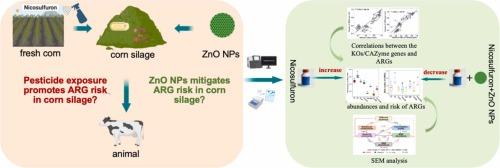Nicosulfuron-driven antibiotic resistance in corn silage: Effect and its mitigation by zinc oxide nanoparticles
IF 11.3
1区 环境科学与生态学
Q1 ENGINEERING, ENVIRONMENTAL
引用次数: 0
Abstract
Antibiotic resistance genes (ARGs) present in animal feed represent a significant threat to human health via the food chain, and pesticide application in crop production may further accelerate the ARGs dissemination. Corn silage, a primary forage for herbivorous livestock, has been shown to harbor diverse ARGs; however, the impact of pesticide-induced stress and potential mitigation strategies on ARG proliferation remains poorly understood. This study investigated the mechanistic link between nicosulfuron exposure and ARG dynamics in corn silage, as well as the mitigating effects of zinc oxide nanoparticles (ZnO NPs) on ARG under nicosulfuron exposure using metagenomic sequencing and high-throughput quantitative PCR. Nicosulfuron exposure increased (P < 0.05) ARG diversity and abundance, enriched (P < 0.05) ARG-hosting genera such as Pantoea, Escherichia, and Klebsiella, and intensified (P < 0.05) the correlation between ARGs and mobile genetic elements (MGEs). Additionally, it disrupted microbial metabolic pathways and elevated (P < 0.05) the ARG-associated risk index in corn silage. Conversely, ZnO NPs alleviated (P < 0.05) these effects by reducing the abundance of key ARGs-bacA, tetM, and ermB, enhancing microbial diversity, promoting beneficial genera such as Levilactobacillus and Companilactobacillus, and decreasing the complexity of ARG-MGE-microbe co-occurrence networks in corn silage under nicosulfuron exposure. Structural equation modeling indicated that there was a significant association between bacterial community and ARGs proliferation, and it had the strongest explanatory power for the variation in ARGs abundance, followed by MGEs. These findings underscore the ecological risks associated with nicosulfuron and demonstrate that ZnO NPs have the potential to mitigate ARGs dissemination in pesticide-contaminated silage. However, this potential does not qualify ZnO NPs as an effective strategy, and their role in promoting safer forage production still requires further evaluation.

镍磺隆驱动的玉米青贮抗生素耐药性:氧化锌纳米颗粒的影响及其缓解
动物饲料中存在的抗生素耐药基因(ARGs)通过食物链对人类健康构成重大威胁,而作物生产中的农药应用可能进一步加速ARGs的传播。玉米青贮是草食性牲畜的主要饲料,已被证明含有多种ARGs;然而,农药引起的应激和潜在的缓解策略对ARG增殖的影响仍然知之甚少。本研究利用宏基因组测序和高通量定量PCR技术研究了镍磺隆暴露与玉米青贮ARG动态之间的机制联系,以及氧化锌纳米颗粒(ZnO NPs)对镍磺隆暴露下ARG的缓解作用。nico磺隆暴露增加了ARG的多样性和丰度(P < 0.05),增加了Pantoea、Escherichia和Klebsiella等ARG寄主属(P < 0.05),增强了ARG与移动遗传元件(MGEs)的相关性(P < 0.05)。此外,它破坏了玉米青贮微生物代谢途径,提高了玉米青贮arg相关风险指数(P < 0.05)。相反,ZnO NPs通过降低关键ARGs-bacA、tetM和ermB的丰度,增强微生物多样性,促进有益菌如乳酸杆菌和Companilactobacillus,降低镍硫隆暴露下玉米青贮args - mge -微生物共生网络的复杂性来缓解(P < 0.05)这些影响。结构方程模型表明,细菌群落与ARGs增殖之间存在显著相关性,对ARGs丰度变化的解释力最强,其次是MGEs。这些发现强调了与尼科隆相关的生态风险,并表明ZnO NPs有可能减轻农药污染青贮饲料中ARGs的传播。然而,这种潜力并不能使ZnO NPs成为有效的策略,它们在促进更安全的饲料生产中的作用仍需要进一步评估。
本文章由计算机程序翻译,如有差异,请以英文原文为准。
求助全文
约1分钟内获得全文
求助全文
来源期刊

Journal of Hazardous Materials
工程技术-工程:环境
CiteScore
25.40
自引率
5.90%
发文量
3059
审稿时长
58 days
期刊介绍:
The Journal of Hazardous Materials serves as a global platform for promoting cutting-edge research in the field of Environmental Science and Engineering. Our publication features a wide range of articles, including full-length research papers, review articles, and perspectives, with the aim of enhancing our understanding of the dangers and risks associated with various materials concerning public health and the environment. It is important to note that the term "environmental contaminants" refers specifically to substances that pose hazardous effects through contamination, while excluding those that do not have such impacts on the environment or human health. Moreover, we emphasize the distinction between wastes and hazardous materials in order to provide further clarity on the scope of the journal. We have a keen interest in exploring specific compounds and microbial agents that have adverse effects on the environment.
 求助内容:
求助内容: 应助结果提醒方式:
应助结果提醒方式:


